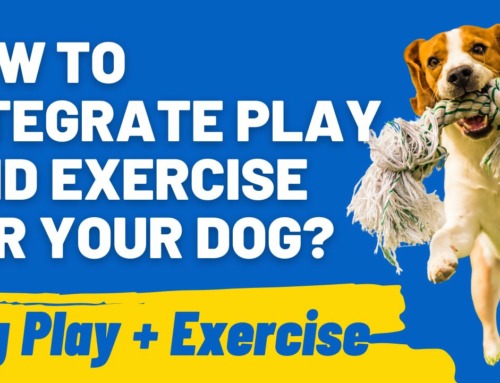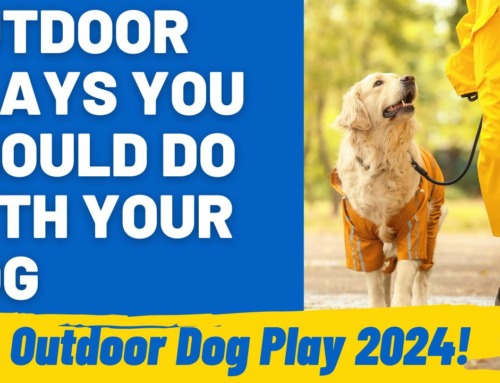Leash training a puppy is more than just teaching them to walk politely on a leash. It’s like giving your pup the keys to the city while ensuring they’re safe and sound by your side.
In this comprehensive training guide, we’re diving into the nitty-gritty of how to achieve those obedient walks every dog owner dreams of.
Why is leash training important for puppies?
Leash training is a crucial part of puppy training and essential for fostering canine obedience. Think of it as giving your puppy the skills they need to explore the world safely while staying under your guidance.
Puppies are naturally curious and full of energy. Leash training helps keep them safe while teaching them how to behave on walks.
It’s not just about controlling them but teaching boundaries and responsiveness to commands.
For puppy parents, leash training builds a strong bond with your furry friend. It’s a way to communicate and work together, creating a respectful and cooperative relationship.
Beyond walks, leash training helps with discipline and socialization. It sets the groundwork for your puppy to interact well with others, both dogs and people, leading to a well-adjusted and obedient companion.
As dog lovers, we want our pups to enjoy exploring while staying safe. Leash training ensures this, making walks enjoyable and secure, deepening the connection between you and your beloved pet.
When should you start leash training your puppy?

Starting leash training for your furry pal is crucial, but there’s no one-size-fits-all answer for the perfect age.
Typically, kicking off around 8 to 10 weeks works well, but it’s not just about the numbers.
Here’s what to consider:
- Physical Readiness: Check if your pup’s comfy wearing a collar or harness without strain. It’s all about their comfort and safety.
- Health and Wellness: Ensure your vet gives the green light. Good health sets the stage for successful training.
- Temperament and Trust: Gauge your pup’s personality. A calm and curious nature sets the tone for easier training sessions.
- Bonding Time: Build a solid bond before introducing the leash. Trust is the key ingredient here.
- Training Environment: Start in a quiet, familiar spot. Fewer distractions help focus on training.
Remember, each pup is unique. Read their cues and take it slow. Patience and understanding of their readiness make for successful leash training sessions.
Essential Equipment for Leash Training
When preparing for leash training, gathering the right gear is crucial for a successful experience that promotes leash skills development.
Here’s a concise breakdown of the must-have equipment ensuring your puppy’s comfort and safety:
| Equipment Type | Description | Suitable For |
| Standard Leash | Durable, 4 to 6 feet in length for control. Made of nylon or leather. | All breeds and sizes, basic walks, and training. |
| Retractable Leash | Flexible, variable lengths for controlled exploration. Requires careful handling. | Spacious areas, controlled freedom during walks. |
| Training Leash | Specifically designed for guidance during training sessions. Provides extra control. | Ideal for focused training, aiding teaching moments. |
| Buckle Collar | Traditional collar with buckle closure, available in various materials. | All breeds and sizes, standard collar for leash attachment. |
| Martingale Collar | Prevents escape, adjusts with pulls. | Puppies prone to slipping out of collars. |
| Back-Clip Harness | Even pressure distribution, prevents neck strain. | Small breeds or puppies needing gentler leash approach. |
| Front-Clip Harness | Encourages loose leash walking, great for training purposes. | Teaches puppies to walk without pulling on the leash. |
Choose gear based on your puppy’s size, breed, and temperament. Prioritize comfort and fit. Introduce the equipment gradually, associating it positively to aid their adjustment.
By understanding and using the right equipment, you pave the way for effective leash training and enjoyable walks with your furry companion.
How to introduce your puppy to the leash?
Introducing your furry friend to their first puppy leash is a gradual process, much like teaching them any new trick. You want them to associate the leash with positive vibes – fun walks, adventures, and quality time together.
Here’s a step-by-step training approach to make your furry friend embrace their leash like a champ:
1. Friendly Sniffs: Let your pup explore the leash with their nose. It’s like saying, “Hey, what’s this neat thing?”
2. Casual Leash Time: Try draping the leash on your puppy during chill moments. No pressure, just getting used to the feel.
3. Baby Steps: Clip the leash on for short periods during cozy times. Treats and cuddles make this part awesome!
4. Positive Vibes: Every time the leash comes out, celebrate! Treats, praise, and snuggles turn the leash into a symbol of fun.
And here is a recommended puppy leash training schedule:
| Age | Sessions/Day | Duration/Session |
| 8-10 weeks | 2-3 | 5-10 mins |
| 10-16 weeks | 3-4 | 10-15 mins |
| 16+ weeks | 4-5 | 15-20 mins |
This table helps plan puppy leash training sessions based on age. But remember, take it slow and focus on your pup’s comfort and progress.
What are the basic leash training commands?

During puppy walks, knowing key training commands is crucial. These commands aren’t just about control—they shape safe and enjoyable leash experiences for dog owners, puppy parents, and pet enthusiasts alike.
- Sit Command: Teaching your pup to “sit” isn’t just about getting them to rest; it’s about control during walks, ensuring a safer and more orderly outing.
- Stay Command: “Stay” helps keep your furry friend in place, fostering discipline and curbing impulsive behavior during walks.
- Heel Command: Mastering “heel” encourages calm, synchronized walks, enhancing the entire Puppy Walks experience.
- Leave It Command: “Leave it” redirects your pup from potential hazards, making walks safer and more enjoyable.
By incorporating these basic leash training commands into puppy walks, you’re not just teaching leash manners.
You’re creating a harmonious walking routine, strengthening your bond with your pup while fostering canine leash manners that ensure enjoyable and respectful interactions during outings.
What are the best walking techniques for leash training?
When it comes to leash training, mastering various walking techniques can greatly influence your pup’s behavior and enjoyment during walks.
Let’s explore a few effective methods to enhance your training experience.
Loose Leash Walking: Harmony on the Go
Walking with a loose leash means no pulling or tugging. This technique encourages your pup to walk calmly by your side, allowing for a pleasant and controlled walk.
How to Achieve It: Hold the leash relaxed yet short. Encourage your pup to stay nearby using treats or verbal cues like “heel.” Consistently reward the desired position.
Clicker Training: Building Association
Using a clicker can aid in reinforcing desired behaviors during leash training. Click when your pup maintains the desired position, associating the sound with positive outcomes.
How to Use a Clicker: Introduce the clicker during short training sessions. Click and treat whenever your pup walks alongside you or follows commands.
Redirection Techniques: Managing Distractions
Distracted pups can challenge leash training. Redirect their attention by using toys or treats to regain focus and reinforce walking manners.
Redirection Tips: When your pup gets distracted, use a toy or treat to redirect their focus back to walking alongside you.
Stop-and-Go Method: Reinforcing Control
This technique involves stopping whenever your pup pulls on the leash, teaching them that pulling doesn’t lead to moving forward.
How to Implement: When your pup pulls, stop walking. Once they relax the tension on the leash, resume walking. Repeat consistently.
Utilizing various walking techniques can significantly contribute to successful leash training. Each method aims to reinforce positive behaviors and create an enjoyable walking experience for both you and your beloved pup.
How to establish a walking routine for your puppy?
Creating a consistent walking routine for your pup is akin to establishing their daily rhythm—it’s a combination of exercise, exploration, and bonding time.
As a dog lover and responsible puppy parent, you want to set the right pace for your furry friend’s growth and happiness.
Here are some helpful tips to ensure a paw-sitive experience for both of you:
1. Start Gradually: Begin with short walks in familiar areas, gradually increasing distance and duration as your puppy grows.
2. Ideal Frequency: Aim for three short walks a day for young puppies, adjusting based on their needs and energy levels.
3. Duration and Pace: Balance exercise without overexertion. Short, frequent walks suit puppies, gradually increasing the duration as they grow.
4. Optimal Timing: Choose cooler times like early mornings or evenings for walks. These times offer comfort and fewer distractions for focused training.
5. Explore and Train: Encourage exploration and reinforce training commands during walks, making it a holistic learning experience.
6. Adapt as They Grow: Adjust the routine as your puppy ages. Older puppies may need longer walks and varied environments for engagement.
Establishing a walking routine isn’t just about exercise. It’s about nurturing a deeper connection with your furry companion while supporting their physical and mental development.
How to reinforce positive behavior during leash training?
Understanding dog behavior is key to successful leash training. Positive reinforcement, which involves rewarding desired behavior, is a powerful tool in shaping your pup’s actions.
Dogs respond positively to rewards like treats, verbal praise, or affectionate gestures when they exhibit the behavior you desire. This strengthens their understanding of what pleases you.
Consistency is crucial. Reinforcing desired behavior consistently helps your pup learn, creating a positive association between the action and the reward.
For instance, incorporating interactive tools, like the Hide’n’Treat, can be an excellent way to reinforce positive behavior during leash training. By rewarding your pup with a treat from the toy when they walk calmly or respond promptly to commands, you create a rewarding experience that encourages good behavior.
In addition, it’s equally important to redirect or ignore unwanted behavior without resorting to punishment. Redirecting their attention to desired behavior and then rewarding it fosters a positive learning experience.
Common challenges in leash training and how to overcome them

Leash training your adorable pup can be an exciting journey, yet it’s not without its hurdles.
Let’s dive into some common roadblocks you might encounter and how to conquer them effortlessly in your dog training adventure.
Pulling on the leash
One of the most prevalent challenges is when puppies pull on the leash, eager to lead the way.
To address this, consider teaching the “heel” command. Redirect their attention by rewarding them when they walk beside you. Maintain a consistently loose leash to discourage pulling.
Distractions during walks
Squirrels, enticing scents, and fellow furry pals can easily divert your pup’s attention during walks.
Combat this by incorporating training sessions in distracting environments. Utilize treats or toys to regain their focus, gradually improving their attention span amidst distractions.
Resistance to the leash
Some pups might resist the leash due to discomfort or fear.
Introduce the leash gradually, associating it with positive experiences like treats or playtime. Patience and gentle encouragement can help your pup feel more at ease with the leash.
Excessive energy during walks
High-energy breeds might exhibit hyperactivity during walks, making it challenging to maintain control.
Prioritize mental and physical exercise before the walk, ensuring your pup is adequately tired. Engage in obedience training sessions to redirect their excess energy positively.
Reactivity towards other dogs or stimuli
When encountering other dogs or stimuli, your pup might bark or lunge, causing stress.
Use positive reinforcement techniques to desensitize them. Create distance from triggers and reward calm behavior, gradually reducing their reactivity over time.
Inconsistency in training
Consistency is key in any training regimen.
Avoid mixed signals by sticking to the same commands and methods. Ensure all family members or caregivers are on the same page regarding training techniques and rules.
Every pup is unique, and overcoming these challenges might take time and patience. Stay persistent, maintain a positive attitude, and celebrate small victories along the way.
Conclusion
Leash training your puppy isn’t just about teaching them to walk beside you. It’s about building a strong bond and ensuring their safety.
By starting early, using positive reinforcement, and being patient, you’re laying the groundwork for a well-behaved and obedient canine companion.
Embrace the journey of leash training, and enjoy the rewarding experience of watching your puppy grow into a confident and mannered dog during walks.
Start leash training the HoundGames way!
Ready to embark on a leash training journey that’ll strengthen your bond with your furry companion?
Discover our range of interactive dog toys and invaluable resources at HoundGames to complement your training efforts. Elevate every walk with your pup and create lasting memories while reinforcing good behavior.
Visit HoundGames now to explore our selection!




